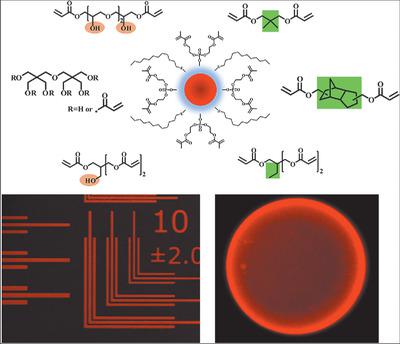当前位置:
X-MOL 学术
›
Macromol. Chem. Phys.
›
论文详情
Our official English website, www.x-mol.net, welcomes your feedback! (Note: you will need to create a separate account there.)
Design Principle of Reactive Components for Dimethacrylate‐Terminated Quantum Dots: Preserved Photoluminescent Quantum Yield, Excellent Pattern Uniformity, and Suppression of Aggregation in the Matrix
Macromolecular Chemistry and Physics ( IF 2.5 ) Pub Date : 2020-01-29 , DOI: 10.1002/macp.201900488 Seonwoo Lee 1
Macromolecular Chemistry and Physics ( IF 2.5 ) Pub Date : 2020-01-29 , DOI: 10.1002/macp.201900488 Seonwoo Lee 1
Affiliation

|
With the advent of various quantum dot (QD)‐based application technologies, the demand for low‐cost, eco‐friendly, high‐performance nanocomposites (e.g., QD photoresist) is rapidly increasing. However, the aggregation phenomenon due to incompatibility between QDs and components is still a limitation in industrial use. Herein, the principle of selecting reactive components that inhibit aggregation and preserve photoluminescent properties is presented. For model QDs (bis[2‐(methacryloyloxy)ethyl] phosphate/1‐dodecanethiol [BMEP/DDT] capped QDs), BMEP allows copolymerization and coadded DDT minimizes the loss of absolute quantum yield during ligand exchange. Besides, bisphenol A ethoxylate dimethacrylate (Mn: ≈1700, polyethylene oxide) suppresses aggregation in the matrix and provide high solubility in alkaline solution. More specifically, the coated thin film (1.0 µm thick) containing up to 20.0 wt% QDs exhibits not only transmittance of more than 85% at 550 nm, but also excellent pattern uniformity at high resolution.
中文翻译:

二甲基丙烯酸酯封端的量子点反应组分的设计原理:保留的光致发光量子产率,优异的图案均匀性和基质中的聚集抑制
随着各种基于量子点(QD)的应用技术的出现,对低成本,环保,高性能纳米复合材料(例如QD光刻胶)的需求正在迅速增长。然而,由于量子点与组件之间不兼容而导致的聚集现象仍然是工业应用中的限制。在此,提出选择抑制聚集并保持光致发光性质的反应性成分的原理。对于模型量子点(双[2-(甲基丙烯酰氧基)乙基]磷酸酯/ 1-十二烷硫醇[BMEP / DDT]封端的量子点),BMEP允许共聚,共掺DDT可以最大程度地减少配体交换过程中绝对量子产率的损失。此外,双酚A乙氧基化物二甲基丙烯酸酯(M n:≈1700,聚环氧乙烷)抑制基质中的聚集并在碱性溶液中提供高溶解度。更具体地,包含高达20.0重量%的QD的涂覆的薄膜(1.0μm厚)不仅在550nm下显示出大于85%的透射率,而且在高分辨率下还具有优异的图案均匀性。
更新日期:2020-01-29
中文翻译:

二甲基丙烯酸酯封端的量子点反应组分的设计原理:保留的光致发光量子产率,优异的图案均匀性和基质中的聚集抑制
随着各种基于量子点(QD)的应用技术的出现,对低成本,环保,高性能纳米复合材料(例如QD光刻胶)的需求正在迅速增长。然而,由于量子点与组件之间不兼容而导致的聚集现象仍然是工业应用中的限制。在此,提出选择抑制聚集并保持光致发光性质的反应性成分的原理。对于模型量子点(双[2-(甲基丙烯酰氧基)乙基]磷酸酯/ 1-十二烷硫醇[BMEP / DDT]封端的量子点),BMEP允许共聚,共掺DDT可以最大程度地减少配体交换过程中绝对量子产率的损失。此外,双酚A乙氧基化物二甲基丙烯酸酯(M n:≈1700,聚环氧乙烷)抑制基质中的聚集并在碱性溶液中提供高溶解度。更具体地,包含高达20.0重量%的QD的涂覆的薄膜(1.0μm厚)不仅在550nm下显示出大于85%的透射率,而且在高分辨率下还具有优异的图案均匀性。



























 京公网安备 11010802027423号
京公网安备 11010802027423号